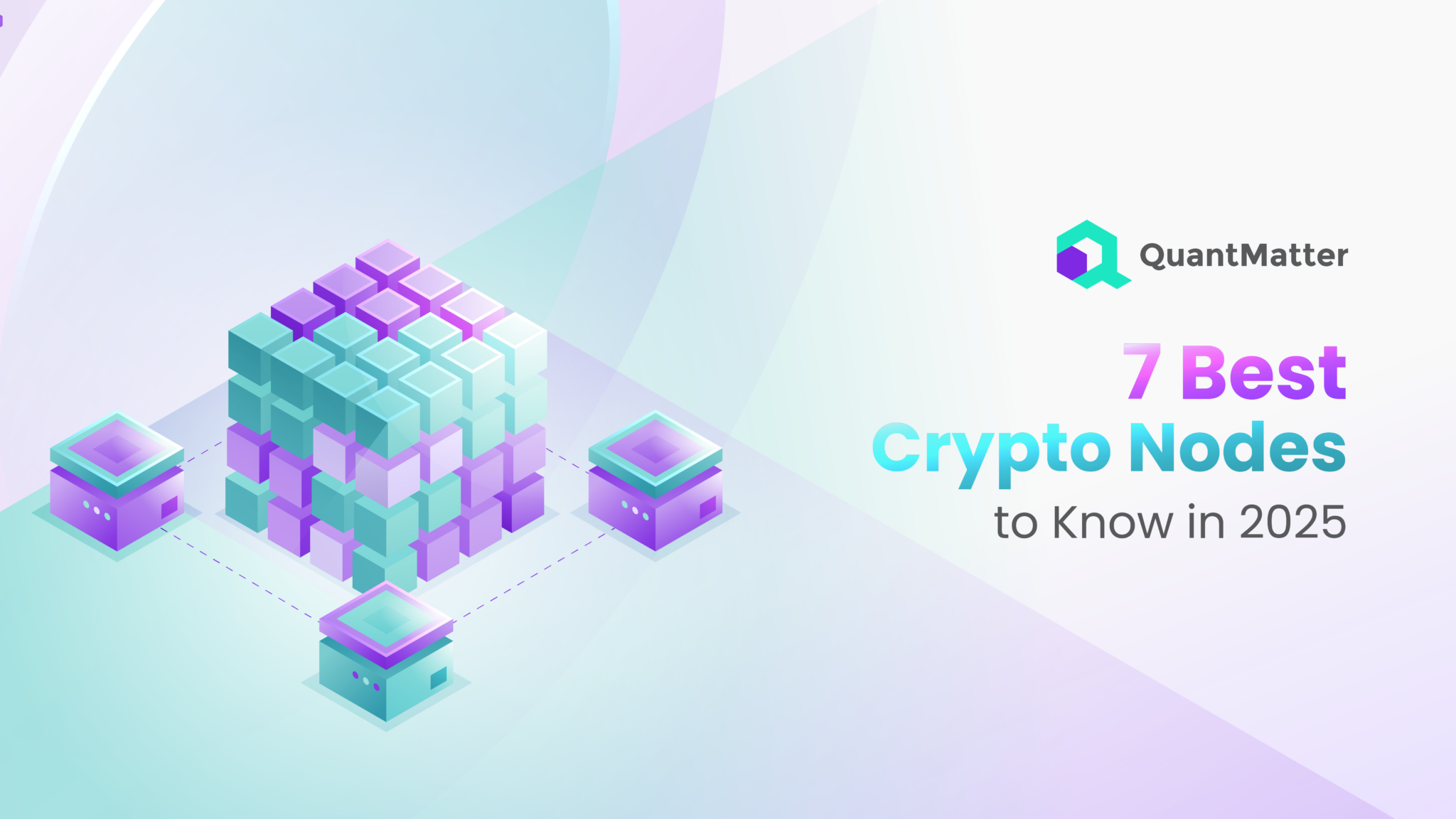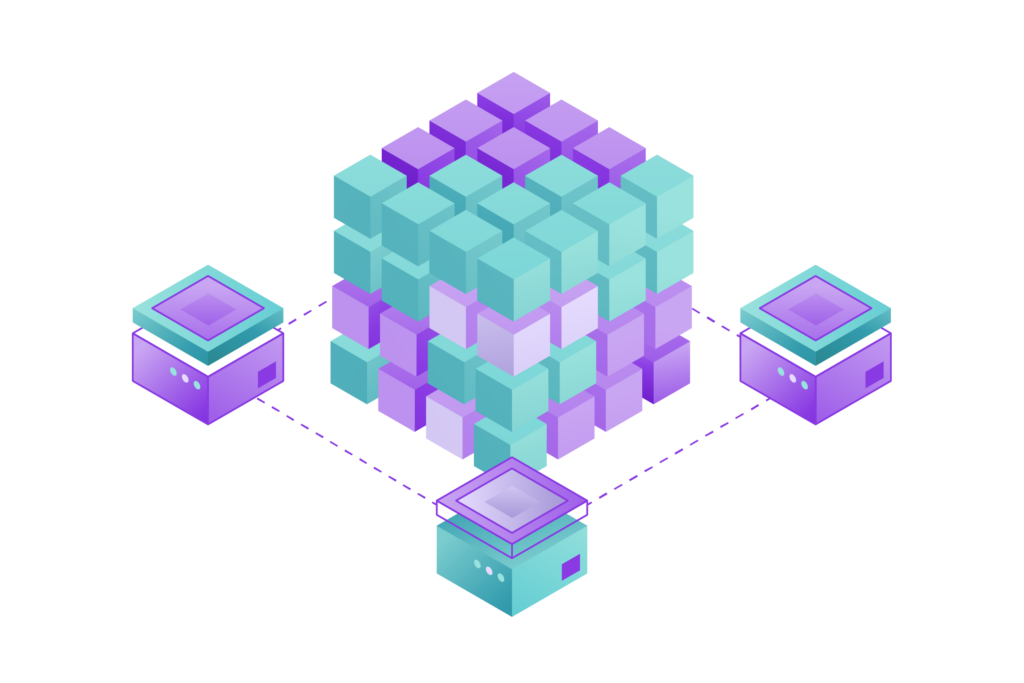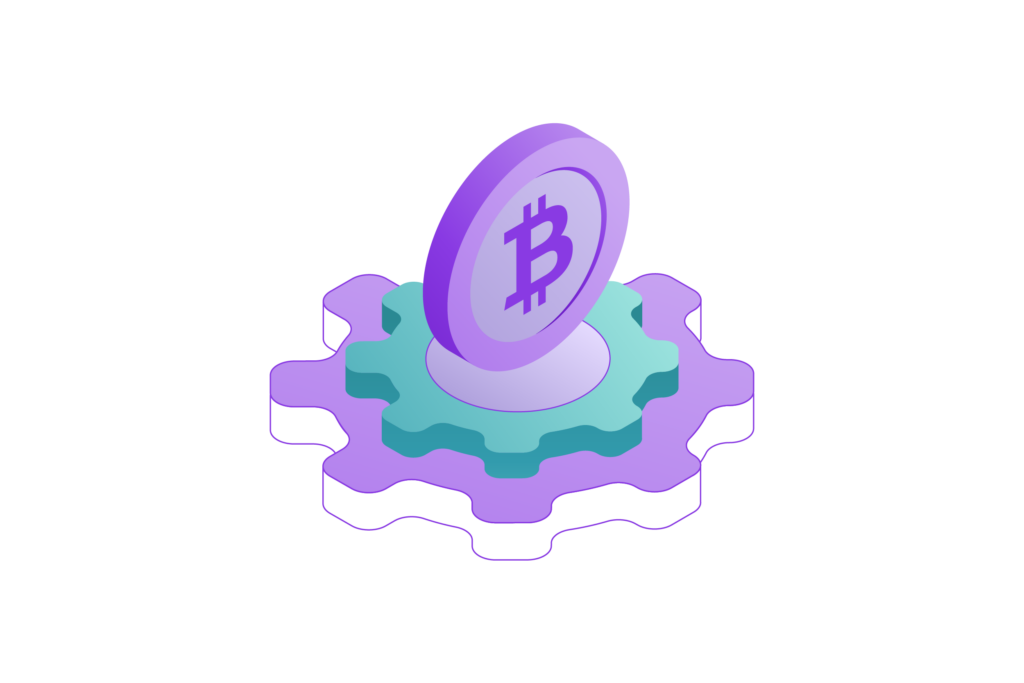
The world of cryptocurrency has grown exponentially, with blockchain technology becoming a cornerstone of various industries. Crypto nodes are crucial in this ecosystem, serving as the backbone of blockchain networks. They validate transactions, maintain network integrity, and enable decentralization.
Understanding crypto nodes can help investors, developers, and enthusiasts navigate the blockchain space more effectively. Nodes come in various types, each serving a specific function, and knowing which ones to watch can provide insights into emerging trends and technologies in 2025.
In this article, we’ll explore the seven best crypto nodes you should know about in 2025 and cover other important aspects of nodes, including how they work, their importance, and tips for selecting the right node for your needs. Let’s dive in.
What Are Crypto Nodes?

A crypto node is a device or program that helps maintain a blockchain network by verifying transactions and storing the blockchain’s history. Think of nodes as the guardians of a decentralized ledger. They ensure that the blockchain operates efficiently and securely without relying on a central authority.
Types of Crypto Nodes
- Full Nodes: These nodes store the entire blockchain ledger, verifying every transaction and block from the genesis block onward.
- Light Nodes: They rely on full nodes for data and only store essential blockchain information.
- Masternodes: These nodes offer additional services like faster transactions or enhanced privacy and typically require staking a significant amount of cryptocurrency.
How Do Nodes Work?
Nodes communicate with each other to share data and validate transactions. For example, when someone makes a cryptocurrency transaction, nodes ensure the transaction is legitimate by checking the sender’s wallet balance and verifying digital signatures. Once confirmed, the transaction is added to a new block and becomes part of the blockchain.
Why Are Crypto Nodes Important?
Crypto nodes are the backbone of blockchain networks. Without them, decentralized systems would fail to function. Nodes provide:
- Decentralization: Nodes allow multiple participants to maintain the blockchain, preventing any single entity from having complete control. This decentralization is critical for ensuring security and fairness in the network.
- Security: By validating transactions and ensuring they meet the network’s protocol, nodes help prevent double-spending and other fraudulent activities.
- Transparency and Accessibility: Nodes ensure that anyone can access the blockchain’s data, promoting trust and transparency among users.
- Enhanced Network Functionality: Certain nodes, like masternodes, enhance the blockchain’s functionality by enabling special features, such as instant transactions or governance voting.
7 Best Crypto Nodes to Know in 2025

In the rapidly evolving world of blockchain technology, understanding the top crypto nodes is essential for enthusiasts and investors. These nodes are the backbone of decentralized networks, ensuring security, efficiency, and scalability. Here are the seven best crypto nodes to know in 2025:
1. HeLa Guardian Node
The HeLa Guardian Node stands as a pivotal component in the HeLa blockchain ecosystem. Serving as vigilant protectors, these specialized nodes ensure the network’s integrity and performance by continuously verifying data to prevent misinformation and malicious activities. By monitoring critical metrics like block production rates and node uptime, they swiftly address potential threats, ensuring a secure environment for decentralized applications (DApps) to function seamlessly.
Operators of HeLa Guardian Nodes are rewarded with HeLa tokens, offering both financial incentives and the opportunity to contribute to a robust blockchain infrastructure. With a limited supply of 50,000 nodes available in tiered releases, early supporters can enjoy exclusive pricing benefits and become integral members of the HeLa community.
| Pros | Cons |
| Enhances network security and data integrity | Limited availability with only 50,000 nodes |
| Provides financial rewards in HeLa tokens | Requires technical knowledge to operate effectively |
| Supports seamless functioning of DApps | Initial investment needed to purchase and set up the node |
| Early supporters enjoy exclusive pricing benefits | Potential risks associated with new blockchain projects |
| Contributes to the growth of a decentralized ecosystem | Dependence on the success of the HeLa network |
2. Ethereum Node
Ethereum, being the pioneer of smart contracts and decentralized applications, relies heavily on its network of nodes. Running an Ethereum node allows individuals to participate directly in network validation, contributing to its security and decentralization. With the transition to Ethereum 2.0 and the adoption of a Proof-of-Stake consensus mechanism, node operators can earn rewards by staking ETH, promoting energy efficiency and scalability.
Operating an Ethereum node requires a minimum stake of 32 ETH, ensuring alignment between participants and the network’s security. As one of the largest and most utilized networks in the crypto space, Ethereum offers significant potential rewards for validators, with an average yield of about 4%.
| Pros | Cons |
| Contributes to the security and decentralization of Ethereum | Requires a minimum of 32 ETH to stake |
| Potential for earning staking rewards | Technical expertise needed for setup and maintenance |
| Supports the operation of smart contracts and DApps | Hardware requirements can be substantial |
| Part of a well-established and widely adopted network | Network congestion can affect node performance |
| Benefits from Ethereum’s continuous development and upgrades | Potential risks associated with cryptocurrency volatility |
Also Read: Risk Management vs Actuary: A Detailed Comparison
3. Avalanche Node
Avalanche is renowned for its high throughput and low latency, capable of processing thousands of transactions per second. Operating an Avalanche node involves participating in the network’s consensus, contributing to its security and efficiency. Node operators are rewarded with AVAX tokens, providing a source of passive income.
The network’s architecture supports the creation of custom blockchains, making it a versatile platform for various applications. Running an Avalanche node requires staking a certain amount of AVAX tokens, aligning operator incentives with network health.
| Pros | Cons |
| High transaction throughput and low latency | Requires staking AVAX tokens to operate |
| Rewards in AVAX tokens | Technical setup can be complex for beginners |
| Supports custom blockchain creation | Network is relatively newer compared to Ethereum |
| Contributes to network security and efficiency | Market volatility can affect token rewards |
| Versatile platform for various applications | Continuous monitoring and maintenance required |
4. Solana Validator Node
Solana is celebrated for its scalability and ultra-fast transaction speeds, making it a preferred choice for developers building decentralized applications. Operating a Solana validator node involves participating in the network’s Proof-of-Stake consensus, contributing to its security and performance. Validators are rewarded with SOL tokens, providing an incentive for maintaining network integrity.
The network’s architecture allows for high throughput, supporting a growing ecosystem of DApps and services. Running a Solana validator requires technical expertise and a stake in SOL tokens, ensuring commitment to the network’s health.
| Pros | Cons |
| Ultra-fast transaction speeds and high scalability | Requires staking SOL tokens to operate |
| Rewards in SOL tokens | Technical setup and maintenance can be complex |
| Supports a growing ecosystem of DApps | Network outages have been reported in the past |
| Contributes to network security and performance | Market volatility can affect token rewards |
| Active community and continuous development | High hardware requirements for optimal performance |
5. Polkadot Validator Node
Polkadot enables interoperability between blockchains, allowing them to communicate and share information seamlessly. Operating a Polkadot validator node involves participating in its nominated Proof-of-Stake consensus mechanism, contributing to the network’s security and governance. Validators are rewarded with DOT tokens, providing an incentive for maintaining network integrity.
The network’s design supports the creation of parachains, enabling specialized blockchains to operate in parallel. Running a Polkadot validator requires technical expertise and staking a certain amount of DOT tokens, ensuring alignment with the network’s goals.
| Pros | Cons |
| Enables interoperability between blockchains | Requires staking DOT tokens to operate |
| Rewards in DOT tokens | Technical setup and maintenance can be complex |
| Supports creation of specialized parachains | Market volatility can affect token rewards |
| Contributes to network security and governance | Continuous monitoring required to maintain performance |
| Active development and strong community support | Competition with other interoperability solutions |
6. Chainlink Node Operator
Chainlink provides decentralized oracle services, enabling smart contracts to interact with real-world data securely. Operating a Chainlink node involves connecting smart contracts to external APIs and off-chain systems, playing a vital role in the ecosystem’s reliability. Node operators are rewarded in LINK tokens, offering a steady stream of income while supporting blockchain functionality.
Chainlink’s robust design ensures secure and tamper-proof data transmission, making it a preferred choice for developers. Running a Chainlink node requires technical expertise and a commitment to maintaining high availability to ensure reliable service delivery.
| Pros | Cons |
| Provides essential services for smart contract functionality | Requires technical knowledge for setup and maintenance |
| Rewards in LINK tokens | High availability and uptime needed for reliability |
| Supports a broad range of blockchain ecosystems | Network competition may impact node usage |
| Robust security for data transmission | Initial setup can be complex |
| Active development and expanding use cases | Volatility in LINK token rewards |
7. Cosmos Validator Node
Cosmos focuses on interoperability and scalability, creating a network of interconnected blockchains. Running a Cosmos validator node involves participating in the network’s Proof-of-Stake consensus, ensuring security and efficiency. Validators earn rewards in ATOM tokens, aligning incentives with the network’s performance.
The Cosmos SDK simplifies the process of building blockchains, attracting developers and expanding the ecosystem. Operating a Cosmos node requires a stake of ATOM tokens and technical expertise, making it a commitment for those who wish to contribute to its growth.
| Pros | Cons |
| Supports interoperability between blockchains | Requires staking ATOM tokens |
| Rewards in ATOM tokens | Technical setup and maintenance can be complex |
| Encourages innovation with the Cosmos SDK | Market volatility may affect rewards |
| Active community and continuous ecosystem expansion | Higher competition among validators |
| Scalable and efficient network design | Requires active monitoring and maintenance |
Crypto nodes are vital to blockchain networks, ensuring security, validation, and decentralization. Running a node offers financial rewards and a chance to contribute to advanced technology. As the industry evolves in 2025, these nodes present excellent opportunities for involvement. Choose wisely and play a role in shaping the future of decentralization.
How to Set Up a Crypto Node

Setting up a crypto node can be a rewarding endeavor for those looking to deepen their involvement in blockchain technology, whether for personal interest, financial gain, or contributing to the decentralized ecosystem. Here’s a step-by-step guide to help you navigate the process.
1. Choose the Right Blockchain
Begin by identifying which blockchain aligns with your goals and interests. Each blockchain has unique features and benefits. For example, Ethereum 2.0 validators attract users seeking staking rewards, while Bitcoin nodes are ideal for enthusiasts of the original cryptocurrency who wish to contribute to its decentralization. Research thoroughly to understand the specific requirements and opportunities associated with your choice.
2. Meet Hardware Requirements
Running a crypto node typically demands a dedicated computer with ample resources. Ensure your setup includes sufficient storage, robust processing power, and a stable internet connection. These factors are critical for maintaining a reliable node that contributes effectively to the network. For instance, hosting a full Bitcoin node might require hundreds of gigabytes of disk space.
3. Follow Installation Guidelines
Most blockchain projects offer comprehensive documentation and tools to facilitate node installation. Visit the official website or repository of your chosen blockchain to find step-by-step instructions. For Bitcoin, Bitcoin Core provides detailed guidance, while Ethereum and other platforms have tailored resources to simplify the process. Take time to carefully follow the instructions to avoid potential errors during setup.
4. Stay Updated
Once your node is operational, regular maintenance is crucial. Blockchain protocols are frequently updated to enhance security, performance, and functionality. Keep your node software updated to ensure it remains compatible with the latest protocol versions and continues to function optimally within the network.
Setting up a crypto node is a practical way to engage with blockchain technology, whether as a hobbyist or an active participant in the ecosystem. By choosing the right blockchain, preparing the necessary hardware, following installation steps, and staying vigilant about updates, you can ensure your node operates smoothly and contributes value to the network. Embarking on this journey not only empowers you with technical knowledge but also connects you with a global community dedicated to decentralization and innovation.
Benefits and Challenges of Running Your Own Crypto Node
Running your own crypto node is a powerful way to engage directly with blockchain technology. It allows you to take greater control of your transactions, contribute to the network’s security, and even earn rewards in certain cases. However, it’s essential to understand both the benefits and challenges before diving into this endeavor.
Benefits of Running Your Own Crypto Node
- Increased Privacy: Operating your own node removes dependence on third parties to broadcast transactions, enhancing privacy.
- Full Control: You can independently verify transactions, ensuring they comply with the network’s rules.
- Passive Income Opportunities: Some nodes, such as masternodes or staking nodes, provide rewards for participation.
Also Read: What is Exotics Trading? A Comprehensive Guide for Investors
Challenges of Operating a Crypto Node
- High Initial Costs: Certain nodes require a significant financial investment, particularly those needing staked cryptocurrencies.
- Technical Complexity: Setting up and maintaining a node can be challenging, especially for those new to the technology.
- Energy Consumption: Running a node continuously increases electricity usage, leading to higher costs and environmental concerns.
- Network Connectivity Issues: A stable internet connection is crucial; disruptions can cause downtime and affect performance.
Running your own crypto node can be a rewarding experience for those willing to invest time, effort, and resources. It’s an opportunity to enhance privacy, maintain control, and even earn income while contributing to the blockchain ecosystem. Careful consideration of the challenges will help ensure a successful and sustainable node operation.
Conclusion
Crypto nodes are integral to blockchain networks, ensuring decentralization, security, and functionality. Whether you’re an investor, developer, or enthusiast, understanding these nodes can open up opportunities to participate actively in the crypto space.
As blockchain technology continues to evolve, the role of nodes becomes increasingly important. They serve as the backbone of decentralized systems, enabling networks to operate efficiently and securely.
By setting up your own node or contributing to the network, you can play a vital role in supporting the future of blockchain technology and its vision of a decentralized world.
Disclaimer: The information provided by Quant Matter in this article is intended for general informational purposes and does not reflect the company’s opinion. It is not intended as investment advice or a recommendation. Readers are strongly advised to conduct their own thorough research and consult with a qualified financial advisor before making any financial decisions.

Joshua Soriano
As an author, I bring clarity to the complex intersections of technology and finance. My focus is on unraveling the complexities of using data science and machine learning in the cryptocurrency market, aiming to make the principles of quantitative trading understandable for everyone. Through my writing, I invite readers to explore how cutting-edge technology can be applied to make informed decisions in the fast-paced world of crypto trading, simplifying advanced concepts into engaging and accessible narratives.
- Joshua Soriano#molongui-disabled-link
- Joshua Soriano#molongui-disabled-link
- Joshua Soriano#molongui-disabled-link
- Joshua Soriano#molongui-disabled-link
